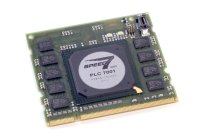Board Controllers, HMIs and a broad range of machinery can benefit from new control capabilities and direct IO- and communication functions. Supporting a very popular programming language, a well-known tool chain and extensive maintenance features will further increase the market acceptance and success of the final product.
I/O Functions
The SODIMM-PLC module is build around profichip s PLC 7001 chip. Based on the core of the PLC 7000 which has been in use for almost four years in over 10000 applications worldwide the PLC 7001 offers extended IO features with up to 32 digital inputs and 24 digital outputs directly on-chip. The IO interface is configurable to provide high level user functions like numerous hardware counter modes.
16 digital inputs can be employed with on-chip alarm functionality which results in low latency and fast response times upon critical system conditions and provides the capability to capture time critical events very accurately. The build-in Real-Time-Clock which can be buffered by an external battery allows precise timestamping (1µsec) and clock synchronized control tasks. SSI interface for rotary encoders, 4-channel Pulse-Width-Modulation and Stepper-Motor-Control are to be supported in future firmware updates. If more than 56 digital I/O bits or analog functions are needed aserial I/O bus is provided which can be operated with up to 32 peripheral modules compatible with System 200V/300V from VIPA or other vendors.
User Data Interface
For maximum flexibility and convenient adaption the SODIMM-PLC module is equipped with a 16 bit SRAM interface to an external FPGA or Dual-Port-RAM with up to 1024 bytes address space mapped into the PLC I/O area. This interface can be used to easily share data of external communication interfaces like PROFIBUS- or CAN-Master with the integrated PLC memory as well.
Communication Interfaces
Currently there are three serial interfaces and one Ethernet port available on the SODIMM-PLC module. The serial interfaces are dedicated to MPI communication, PROFIBUS-DP Slave interface (both supporting transmission rates up to 12 MBit/s) and a serial standard interface (e.g. for establishing a Point-To-Point (PtP)communication). The Ethernet port is restricted to PU/OP functionality like hardware configuration, PLC program download and online functions. Alternatively the MPI interface can be used for system setup, program update, debugging and online functions.

